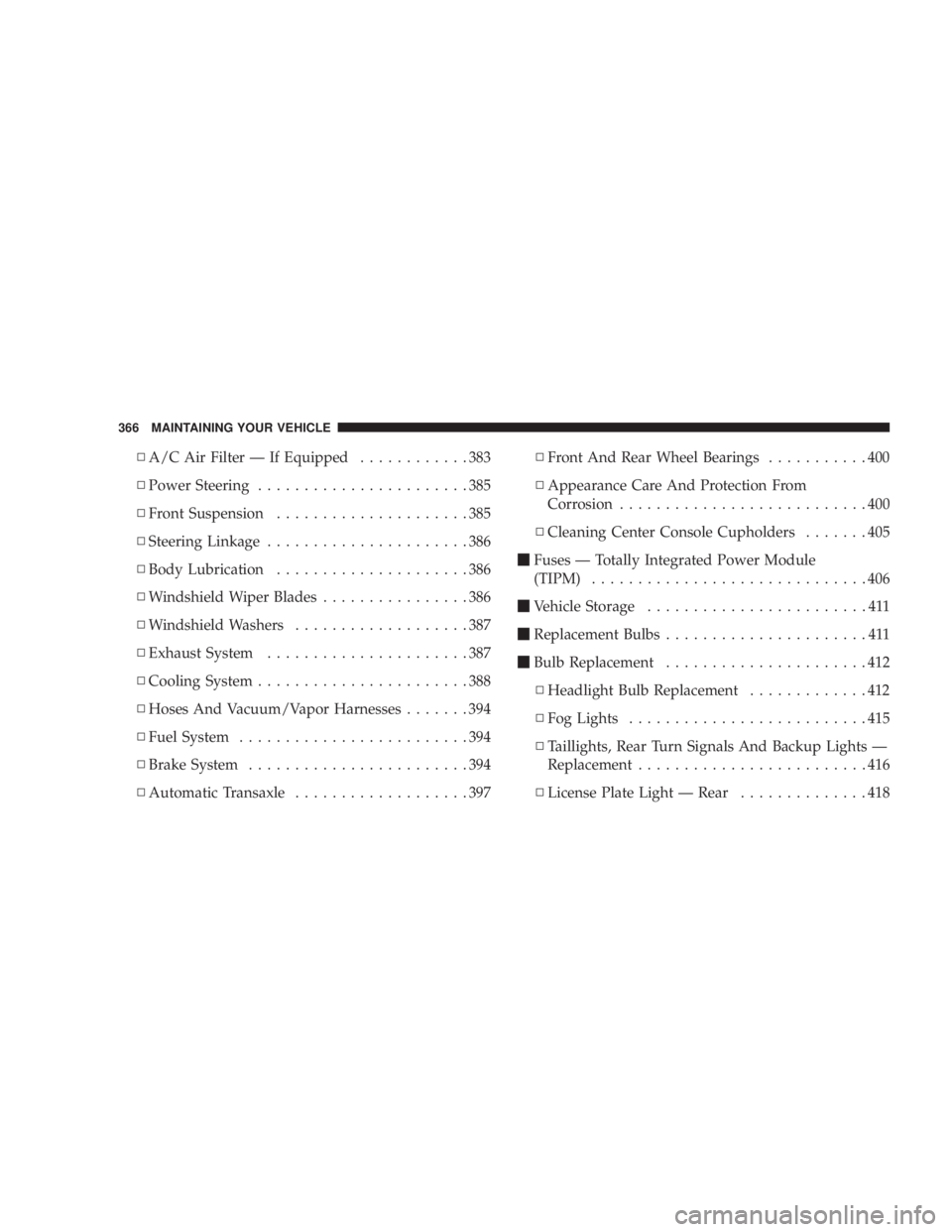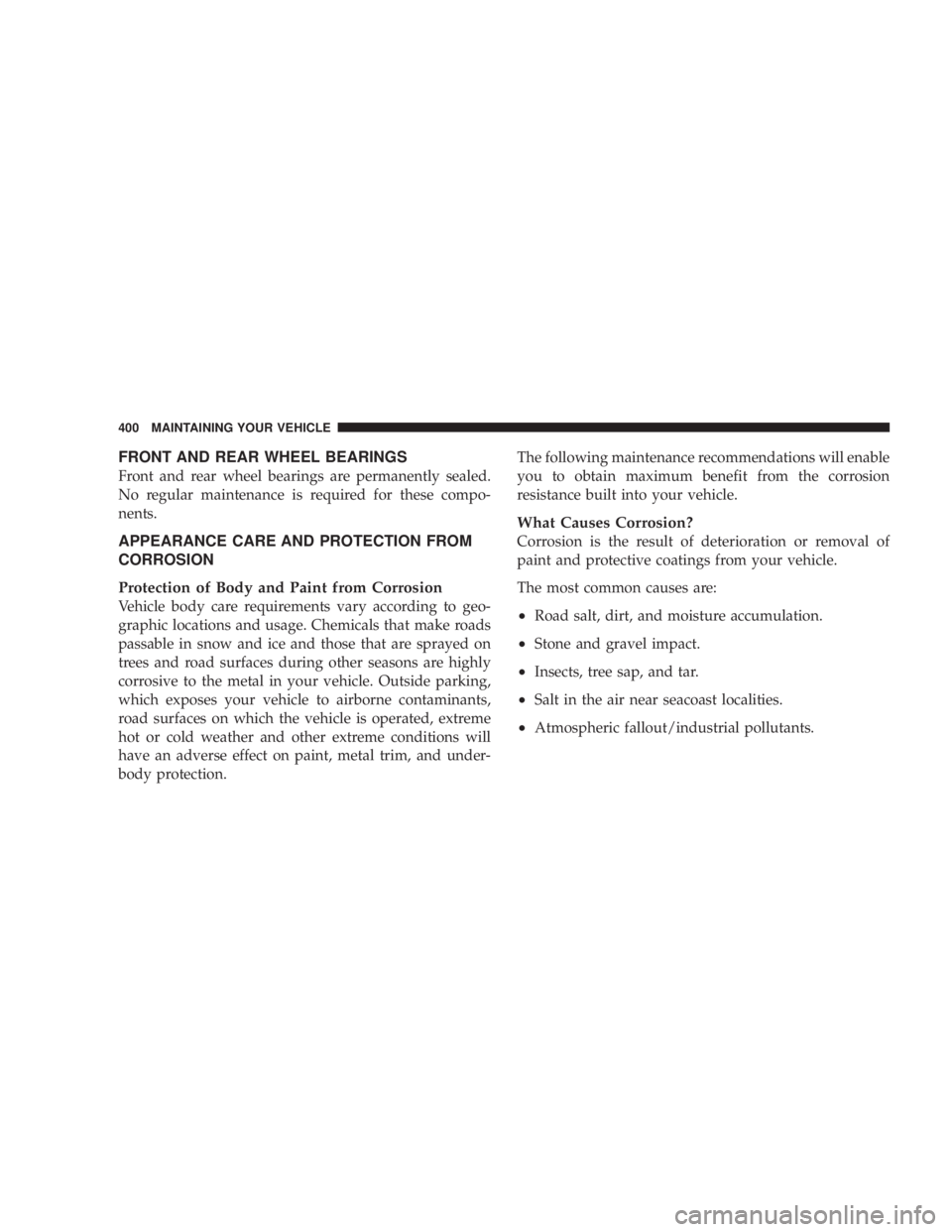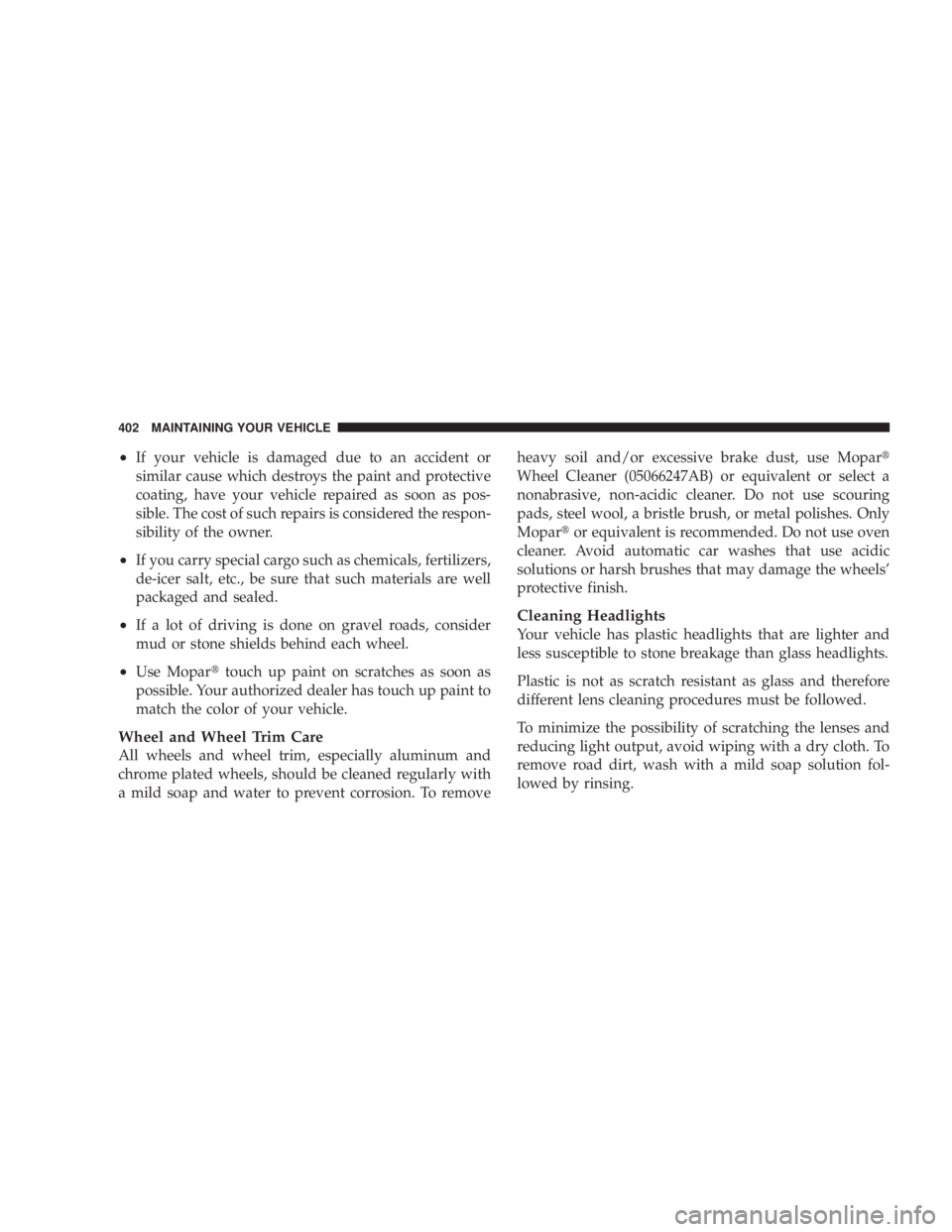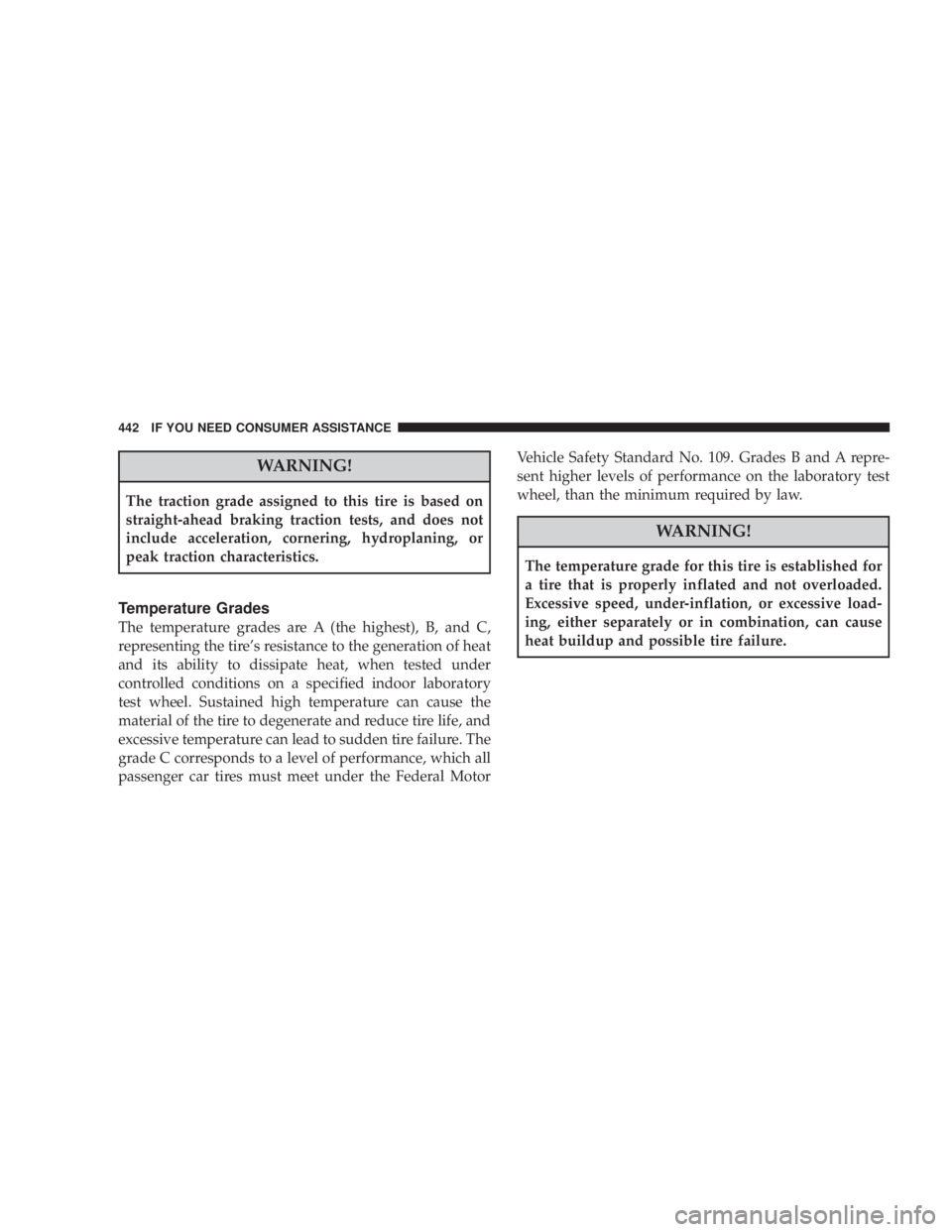Page 366 of 467
TOWING WITHOUT POWER Ð OVERRIDE
TRANSAXLE INTERLOCK SYSTEM
Special care must be taken when the vehicle is towed
with the ignition in the LOCK position. A dolly should be
used under the front wheels if the rear wheels are raised.
Proper towing equipment is necessary to prevent dam-
age to the vehicle.
Battery power is required to release the brake/transaxle
interlock system. There is an override system that allows
you to shift out of PARK in case of loss of power. To
activate the override system: ² Firmly apply the parking brake.
² Insert the ignition key and rotate it to the ON position.
² Remove the cupholder liner.
² Insert a key, screwdriver, or similar object into the
front hole then push and hold the manual override
release lever forward.
² While holding the release lever forward, move the
shift lever from PARK to NEUTRAL.
² Release the override.364 WHAT TO DO IN EMERGENCIES
Page 368 of 467

N A/C Air Filter Ð If Equipped ............383
N Power Steering .......................385
N Front Suspension .....................385
N Steering Linkage ......................386
N Body Lubrication .....................386
N Windshield Wiper Blades ................386
N Windshield Washers ...................387
N Exhaust System ......................387
N Cooling System .......................388
N Hoses And Vacuum/Vapor Harnesses .......394
N Fuel System .........................394
N Brake System ........................394
N Automatic Transaxle ...................397 N Front And Rear Wheel Bearings ...........400
N Appearance Care And Protection From
Corrosion ...........................400
N Cleaning Center Console Cupholders .......405
m Fuses Ð Totally Integrated Power Module
(TIPM) ..............................406
m Vehicle Storage ........................411
m Replacement Bulbs ......................411
m Bulb Replacement ......................412
N Headlight Bulb Replacement .............412
N Fog Lights ..........................415
N Taillights, Rear Turn Signals And Backup Lights Ð
Replacement .........................416
N License Plate Light Ð Rear ..............418366 MAINTAINING YOUR VEHICLE
Page 383 of 467

To minimize the possibility of catalyst damage:
² Do not shut off the engine or interrupt the ignition
when the transaxle is in gear and the vehicle is in
motion.
² Do not try to start the engine by pushing or towing the
vehicle.
² Do not idle the engine with any ignition coil connec-
tors disconnected for prolonged periods.
MAINTENANCE-FREE BATTERY
You will never have to add water, nor is periodic main-
tenance required.
NOTE: The battery is stored in a compartment behind
the left front fender and is accessible without removing
the tire and wheel. Remote battery terminals are located
in the engine compartment for jump-starting.
To access the battery, turn the steering wheel fully to the
right and remove the inner fender shield. WARNING!² Battery fluid is a corrosive acid solution and can
burn or even blind you. Don't allow battery fluid
to contact your eyes, skin, or clothing. Don't lean
over a battery when attaching clamps. If acid
splashes in eyes or on skin, flush the area imme-
diately with large amounts of water.
² Battery gas is flammable and explosive. Keep
flame or sparks away from the battery. Don't use a
booster battery or any other booster source with an
output greater than 12 volts. Don't allow cable
clamps to touch each other.
² Battery posts, terminals, and related accessories
contain lead and lead compounds. Wash hands
after handling. MAINTAINING YOUR VEHICLE 381
7
Page 402 of 467

FRONT AND REAR WHEEL BEARINGS
Front and rear wheel bearings are permanently sealed.
No regular maintenance is required for these compo-
nents.
APPEARANCE CARE AND PROTECTION FROM
CORROSION
Protection of Body and Paint from Corrosion
Vehicle body care requirements vary according to geo-
graphic locations and usage. Chemicals that make roads
passable in snow and ice and those that are sprayed on
trees and road surfaces during other seasons are highly
corrosive to the metal in your vehicle. Outside parking,
which exposes your vehicle to airborne contaminants,
road surfaces on which the vehicle is operated, extreme
hot or cold weather and other extreme conditions will
have an adverse effect on paint, metal trim, and under-
body protection. The following maintenance recommendations will enable
you to obtain maximum benefit from the corrosion
resistance built into your vehicle.
What Causes Corrosion?
Corrosion is the result of deterioration or removal of
paint and protective coatings from your vehicle.
The most common causes are:
² Road salt, dirt, and moisture accumulation.
² Stone and gravel impact.
² Insects, tree sap, and tar.
² Salt in the air near seacoast localities.
² Atmospheric fallout/industrial pollutants.400 MAINTAINING YOUR VEHICLE
Page 404 of 467

² If your vehicle is damaged due to an accident or
similar cause which destroys the paint and protective
coating, have your vehicle repaired as soon as pos-
sible. The cost of such repairs is considered the respon-
sibility of the owner.
² If you carry special cargo such as chemicals, fertilizers,
de-icer salt, etc., be sure that such materials are well
packaged and sealed.
² If a lot of driving is done on gravel roads, consider
mud or stone shields behind each wheel.
² Use Mopar t touch up paint on scratches as soon as
possible. Your authorized dealer has touch up paint to
match the color of your vehicle.
Wheel and Wheel Trim Care
All wheels and wheel trim, especially aluminum and
chrome plated wheels, should be cleaned regularly with
a mild soap and water to prevent corrosion. To remove heavy soil and/or excessive brake dust, use Mopar t
Wheel Cleaner (05066247AB) or equivalent or select a
nonabrasive, non-acidic cleaner. Do not use scouring
pads, steel wool, a bristle brush, or metal polishes. Only
Mopar t or equivalent is recommended. Do not use oven
cleaner. Avoid automatic car washes that use acidic
solutions or harsh brushes that may damage the wheels'
protective finish.
Cleaning Headlights
Your vehicle has plastic headlights that are lighter and
less susceptible to stone breakage than glass headlights.
Plastic is not as scratch resistant as glass and therefore
different lens cleaning procedures must be followed.
To minimize the possibility of scratching the lenses and
reducing light output, avoid wiping with a dry cloth. To
remove road dirt, wash with a mild soap solution fol-
lowed by rinsing.402 MAINTAINING YOUR VEHICLE
Page 417 of 467
Fog Lights
1. Access to the lights through the lower fascia cutout is
limited.
2. We recommend you access the lights by turning the
steering wheel to allow access and remove the inner
fender shield. 3. Rotate bulb and connector 1
¤ 4
turn counterclockwise.
4. Pull bulb off of connector and replace with a new one.
CAUTION!Do not touch the new bulb with your fingers. Oil
contamination will severely shorten bulb life. If the
bulb comes in contact with an oily surface, clean the
bulb with rubbing alcohol.
Fog Light and Connector MAINTAINING YOUR VEHICLE 415
7
Page 422 of 467
FLUIDS AND CAPACITIES
FLUIDS AND CAPACITIES
Engine U.S. Metric
Fuel (approximate)
All FWD Engines Ð (Except 2.4L PZEV) 16.9 Gals 64 L
3.5L Engine with AWD (All Wheel Drive) 17.3 Gals 65.5 L
2.4L PZEV (Partial Zero Emissions Vehicle) 18.4 Gals 69.7 L
Engine Oil with Filter
2.4 Liter Engine (SAE 5W-20, API Certified) 4.5 Qts 4.26 L
2.7 Liter Engine (SAE 5W-20, API Certified) 5.5 Qts 5.2 L
3.5 Liter Engine (SAE 10W-30, API Certified) 5.5 Qts 5.2 L420 MAINTAINING YOUR VEHICLE
Page 444 of 467

WARNING!The traction grade assigned to this tire is based on
straight-ahead braking traction tests, and does not
include acceleration, cornering, hydroplaning, or
peak traction characteristics.
Temperature Grades
The temperature grades are A (the highest), B, and C,
representing the tire's resistance to the generation of heat
and its ability to dissipate heat, when tested under
controlled conditions on a specified indoor laboratory
test wheel. Sustained high temperature can cause the
material of the tire to degenerate and reduce tire life, and
excessive temperature can lead to sudden tire failure. The
grade C corresponds to a level of performance, which all
passenger car tires must meet under the Federal Motor Vehicle Safety Standard No. 109. Grades B and A repre-
sent higher levels of performance on the laboratory test
wheel, than the minimum required by law.
WARNING!The temperature grade for this tire is established for
a tire that is properly inflated and not overloaded.
Excessive speed, under-inflation, or excessive load-
ing, either separately or in combination, can cause
heat buildup and possible tire failure.442 IF YOU NEED CONSUMER ASSISTANCE